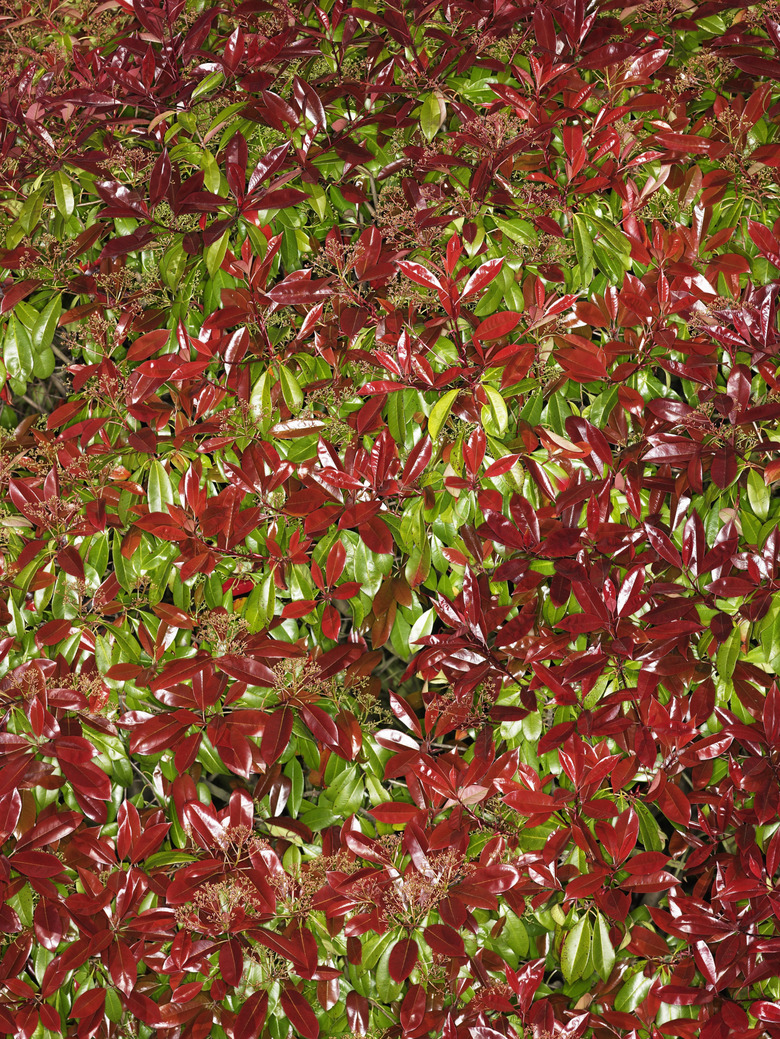How To Correct Iron Chlorosis In Photinia Shrubs
The red-tip photinia is a widely cultivated landscaping shrub, with deep green mature leaves, bright red new growth and white flowers. It's often used as a privacy hedge, as it grows very thick and to a height of 12 feet if left unpruned. Red-tip photinia is prone to yellowing of the leaves in between the leaf veins, a condition called chlorosis, which is caused by iron deficiency. Chlorosis is particularly likely in alkaline soil, which is common in the western part of the United States.
Step 1
Inspect the plant for iron chlorosis symptoms. The leaves will yellow in a distinctive pattern, leaving the leaf veins green. Iron deficiency chlorosis will start in the new foliage, working through older leaves if left untreated.
- The red-tip photinia is a widely cultivated landscaping shrub, with deep green mature leaves, bright red new growth and white flowers.
- Red-tip photinia is prone to yellowing of the leaves in between the leaf veins, a condition called chlorosis, which is caused by iron deficiency.
Step 2
Apply chelated iron to the plant in the form of foliage spray or granular supplements, following package directions. These can be found in any garden center or nursery.
Step 3
Work peat moss into the soil for long-term treatment of chlorosis. This acidic supplement balances the alkaline soil, improving the ability of the plant to absorb iron.
Step 4
Improve soil drainage to increase resistance to chlorosis. Wet soil prevents plant roots from absorbing enough oxygen, leaving them unable to take up iron. Working mulch or compost into the soil can improve drainage.
- Apply chelated iron to the plant in the form of foliage spray or granular supplements, following package directions.
- Work peat moss into the soil for long-term treatment of chlorosis.
Step 5
Apply only low-phosphorous fertilizer. Excess phosphorous can block iron uptake by the plant. Phosphorus content is indicated on the fertilizer package by the middle number in the three-number indicator of fertilizer grade.
Correct Iron Chlorosis In Photinia Shrubs
Confirm your photinia shrubs' chlorosis symptoms match those of iron deficiency. In contrast, nitrogen-deficient leaves, including the veins, turn pale yellow, and older leaves show that symptom first. Repeat the spray application three to five times throughout the year if necessary. Foliar applications of a liquid iron mixture provide shrubs with quick but short-lasting relief from iron chlorosis. Keep soil well-drained and never soggy. Cold temperatures slow photinia root activity and make iron deficiency more pronounced, especially when paired with poor water management. Test the photinias' soil pH level annually, sending soil samples to a laboratory. The higher your soil's pH level, the more frequent or extensive iron applications may need to be.
- Apply only low-phosphorous fertilizer.
- Foliar applications of a liquid iron mixture provide shrubs with quick but short-lasting relief from iron chlorosis.
Things Needed
- Chelated iron
- Peat moss
- Mulch or compost
- Fertilizer low in phosphorus
References
- Gardening Know How: Leaf Chlorosis and Iron for Plants: What Does Iron Do for Plants
- University of California Integrated Pest Management Online: Photinia — Photinia spp.
- University of California Integrated Pest Management Online: Mineral Deficiencies
- California Master Gardener Handbook; Dennis R. Pittenger, Editor
- Texas A&M AgriLife Extension, Extension Education in Bexar County, San Antonio Express News: Straight Talk about Iron Deficiency and Plants
- U.S. Department of Agriculture, Forest Service: Photinia x Fraseri — Fraser Photinia
